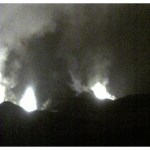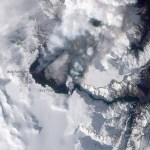Eyjafjöll
Actually, no the volcanoes aren't from space, but pictures of the volcanoes were taken from space. The NASA Earth Observatory has posted three more gems of volcanic activity taken by one of the fleet of earth imagers in orbit:
A recent image of Chaiten taken by EO-1. Image courtesy of the NASA Earth Observatory.
There is a great image of the busy Kamchatkan Peninsula, where four volcanoes are seen erupting in a single image - Kliuchevskoi, Bezymianny, Shiveluch and Karymsky. The plume from Karymsky is especially prominent as a grey streak above the white snow of the Russian winter (albeit…
Quick hits for a Monday morning (however, the week did have a good start).
Lava fountaining on March 27, 2010 at the Eyjafjallajokull-Fimmvörduháls eruption in Iceland.
The Eyjafjallajokull-Fimmvörduháls eruption is still going strong with two active fissure - and a lot of tourists poking around as well. If you watch the webcams closely, you can even see the cars and hikers trekking up near the erupting basaltic fissure (except today, as there seems to be a blizzard). Not to say that people are getting a little, well, nonchalant, but there is a story of serving meals cooked on lava up…
Superfast entry as I run out the door but ...
The new vent that opened on March 31 at Fimmvörðuhálsi in Iceland. The old vent is to the right in the image and new to the left. Image captured at 5:45PM EDT.
A second fissure has opened at the Fimmvörðuhálsi eruption in Iceland. Check out the webcam and you can clearly see a new set of vents (Icelandic - try Google Translate) on the left hand side of the image - and that wasn't there earlier today. You can see an image of the new vents here.
Thank you to all the Eruptions readers who have been keeping us posted!
Busy busy today, so just a brief update on the ongoing Fimmvörðuháls/Eyjafjallajokull eruption in Iceland.
The coalesced vent of the Fimmvörðuháls fissure eruption in late March 2010.
The eruption is still going, albeit potentially with a little less vigor than before - and you can watch it on the Vodafone webcam, along with these other webcams from Mila.is. Haraldur Sigurdsson says that the eruption may have peaked (Icelandic) and is ~25% less vigorous than it was a few days ago, but this could change without notice. A fairly significant, long, low scoria cone has formed and lava…
Alright, I'm actually in Wisconsin right now for a wedding, but this was too cool to pass up ... the folks from the NASA Earth Observatory sent me this image (Natural-color, 10m/pixel) from the Advanced Land Imager aboard EO-1 of the Eyjafjallajokull-Fimmvörduháls eruption, both taken on March 24, 2010.
The Fimmvörduháls eruption in Iceland, taken March 24, 2010. Image courtesy of the NASA Earth Observatory. Click on the image for a larger version.
You can clearly see the flow heading down the drainage to the east, slowly snaking down the snow covered area. I think the steam plume on far…
The fissure vent eruption near Eyjafjallajokull in Iceland. Image by Ãorsteinn Gunnarsson, March 22, 2010.
It has been hard to keep up with the flood of news from the Eyjafjallajokull eruption in Iceland. Eruptions readers have done a good job with getting new images, videos and info up as they happen, so you might want to peruse the comments for those sorts of tidbits (along with discussion of what might be happening).
Here is the latest:
The eruption at Fimmvörduháls (considering the eruption is actually occurring between the ice caps) could last weeks to months, which isn't too…
The steam-and-ash plume from Eyjafjallajokull in Iceland, March 22, 2010.
Overnight, the Eyjafjallajokull eruption in Iceland added to its oeuvre, producing what is being reported to be a 8-km plume. Images of the plume (above) suggest (to me) that it is very water-rich, so likely this is the expanding(?) fissure interacting with snow, ice or groundwater, producing steam explosions. These explosions have some minor ash component to them, mostly from the shattering of rapidly cooled lava, but are dominated by steam.
The eruption appears to be continuing into its third day unabated. Flights…
The fissure vent eruption on Eyjafjallajokull in Iceland on March 21, 2010.
The big news this morning is the eruption that started last night at Eyjafjallajokull in Iceland, producing a 1-km fissure vent. The pictures and videos I've seen so far have been quite impressive, with the classic look of a "curtain of fire", where basaltic lava erupts explosively from a linear array of vents - you can see the geometry in the image from the BBC/AP (above). Especially clear is the dual nature of the eruption, with both the explosive fire fountains and the effusive (passive) lava flows from the root…
A shot from the Hekla webcam showing the glow from the eruption of Eyjafjallajökull that started March 20, 2010.
Quick note, but for those of you who have been following the seismicity at Eyjafjallajökull in Iceland, there is news from Iceland that an eruption has started. I will post more details as I can find them, but so far, evacuations have commenced near the volcano. It sounds like the eruption can be seen coming through the glacier on the volcano, but any real details of the style of volcanism are unknown. This is the first known eruption of Eyjafjallajökull since 1823.
UPDATE 9:40…
Leaving for Death Valley tomorrow - I'll be sure to take some pictures of Ubehebe Crater and the volcano at the Mirage. This will likely be the last new post until about a week from now, but look for the Erta'Ale Volcano Profile, maybe a new Mystery Volcano Photo and I'll leave a thread open for any new volcano news.
Colima in Mexico.
Eruptions reader Tim Stone sent me this image from Japanese astronaut Soichi Noguchi's Twitpic feed - it is a stunner of the caldera on Jebel Marra in Sudan. The only known historical eruption for this volcano was ~2000 BC within the Deriba Caldera, but it has…
Did I mention its a busy week?
The lava lake at Erta'Ale in 2008. Image courtesy of Stromboli Online.
Our Icelandic saga continues, with more earthquakes and more speculation/information on the parts of Eruptions readers. Keep up the discussion - I'll be fascinated to see who turns out to get closest to what actually happens, prediction-wise. The seismicity has quieted somewhat again in the last 12 hours, so we wait eagerly to see what comes next. Remember, Iceland is the land where volcanoes helped change history, so it is always fun to talk Icelandic volcanism.
The NASA Earth Observatory…
Cleaning up some news ... busy week leading up to a field trip I am helping co-lead to Death Valley next week.
Ubehebe Crater in Death Valley, California
First off, I want to say how amazed I am at the great discussion that went on all weekend about the signs of potential activity in Iceland. It now appears that the earthquakes at Eyjafjallajökull may be waning, however the levels of seismicity have definitely bounced up and down over the last few days. However, the level and depth of the conversation is a testament to all volcanophiles out there. Nice job, folks.
For those of you into…
Eyjafjallajökull, an ice-capped volcano in Iceland that last erupted in 1823.
We talked a few weeks ago of signs that there were increasing signs that an eruption could occur on Iceland - increased seismicity on the Reykjanes Ridge suggested that magma might be on the move. Now, we have two pieces of evidence that we might see activity at Eyjafjallajökull, on the southern side of the island nation.
First off, there is a focus of seismicity under the area of Eyjafjallajökull, with an especially large bump in the last 2 days. Both the number and magnitude of the seismicity has been marching…
So, the field still stands unblemished, having identified all 8 MVPs, usually within less than 7 tries. Nice job!
Current MVP Standings:
volcanista - 1
Elizabeth - 1
Ralph - 1
gijs - 1
Anne - 1
Cam - 1
gg - 1
The Bobs - 1
MVP #7 was Arenal in Costa Rica. It was initially going to be Rincon de la Vieja, but somehow I mixed up the pictures. I think a lot of you know a lot more about Arenal than I do, but it is one of the most active - and easily visited - volcanoes in the Western Hemisphere.
Eyjafjöll volcanoHekla from the northwest in Iceland, not your MVP #8.
MVP #8 was Eyjafjöll (or…

